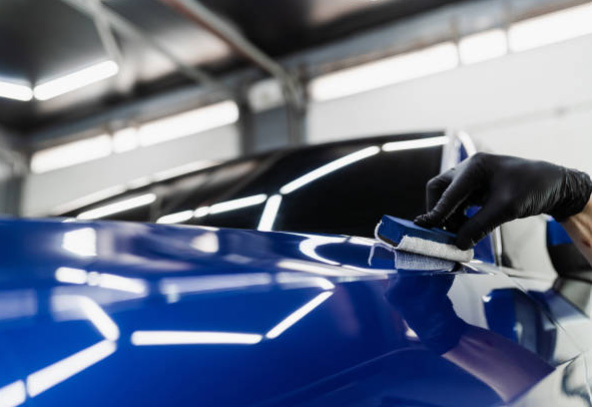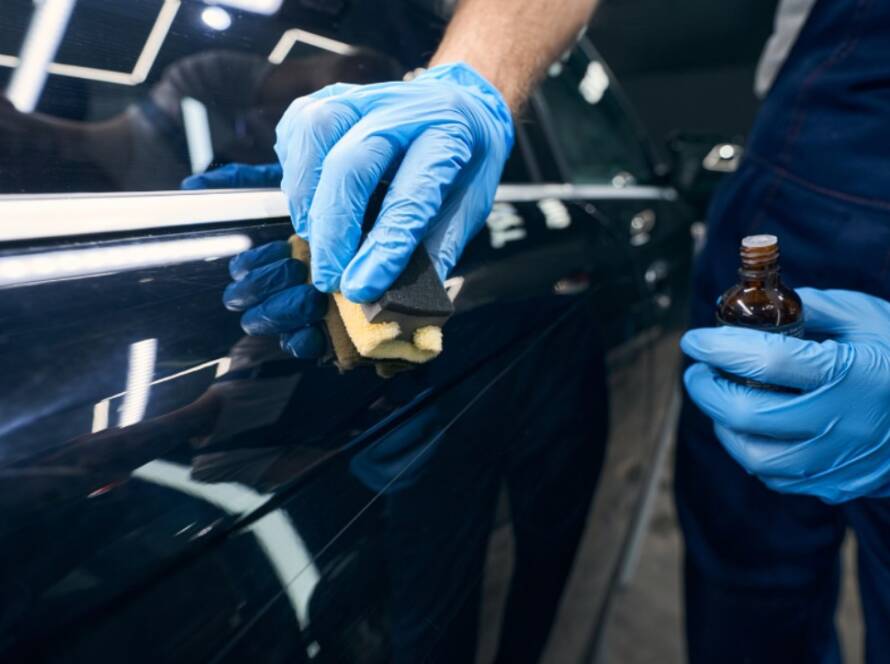Last month, a luxury car owner reached out with a concerning question: “My $3,000 ceramic coating is barely two years old, but water doesn’t bead anymore. Did I get scammed?” This scenario plays out more often than you’d think, and it highlights a critical gap between expectation and reality in the ceramic coating world.
Professional ceramic coatings promise 2-7 years of protection, with some premium options claiming even longer lifespans. Yet many car owners find themselves disappointed when their “lifetime” coating starts showing signs of wear much sooner than expected. The truth is, ceramic coating longevity depends on far more factors than most people realize.
Understanding these factors isn’t just about getting your money’s worth – it’s about protecting one of your most significant investments. Whether you’re driving a weekend exotic or a daily luxury vehicle, knowing how to maximize your coating’s lifespan can save you thousands in reapplication costs and preserve your car’s showroom finish for years to come.
The Reality Behind Coating Failures
The ceramic coating industry has a marketing problem. Advertisements showcase “permanent protection” and “set-and-forget maintenance,” creating unrealistic expectations that lead to customer disappointment. Most coating failures aren’t due to product defects – they’re the result of mismatched expectations and inadequate maintenance.
What Determines Your Coating’s True Lifespan?
Unlike a simple wax that sits on the surface, ceramic coatings form a chemical bond with your paint. This bond’s strength and durability depend on several critical factors that many car owners overlook during the selection and maintenance process.
The Quality Spectrum: Why Not All Coatings Are Created Equal
Think of ceramic coatings like smartphones – there’s a massive difference between a budget Android and the latest iPhone, even though both make calls. The coating market spans from $20 DIY sprays to $5,000+ professional applications, and this price range reflects genuine differences in durability and performance.
Consumer-Grade vs. Professional Systems
Your typical auto parts store coating might contain 10-20% ceramic content (SiO₂), while professional-grade products like Feynlab or Ceramic Pro often contain 70-85% ceramic solids. This isn’t just marketing fluff – higher ceramic content creates a thicker, more durable protective layer.
Consider this real-world comparison: A DIY enthusiast applied a consumer spray coating to their BMW M3. After six months, water beading had completely disappeared. Meanwhile, a similar M3 with professionally applied Feynlab Self-Heal Plus was still performing like new after three years of daily driving.
The Installation Factor: Why Technique Matters More Than Product
Even the world’s best coating will fail if applied incorrectly. Professional installation involves multiple critical steps that most DIY applications skip:
Paint Preparation Deep Dive
Before any coating touches your paint, professionals spend hours preparing the surface. This includes:
Skipping any of these steps creates weak points where the coating can fail prematurely. It’s like trying to paint over rust – the underlying problems will eventually show through.
Controlled Environment Application
Professional installers work in climate-controlled bays with specific temperature and humidity ranges. They use infrared curing lamps to ensure proper chemical cross-linking. Compare this to a DIY application in your garage during a humid summer day – the results simply can’t match.
The Layering Strategy: Building Maximum Protection
High-end coating systems aren’t single products – they’re engineered systems with multiple components:
Base Coat Foundation
The first layer creates the primary bond with your paint and establishes the protective barrier. This coat needs perfect adhesion to support everything that follows.
Mid Coats for Thickness
Additional layers build thickness and durability. Each layer cross-links with the previous one, creating a unified protective film that’s stronger than the sum of its parts.
Top Coat Performance
The final layer provides the hydrophobic properties, gloss enhancement, and sacrificial protection that takes the daily abuse.
Maintenance: The Make-or-Break Factor
Here’s where most coating failures actually originate. The “no maintenance required” myth has probably caused more coating disappointments than any other factor. Let’s debunk this completely.
The Two-Bucket Method Revolution
Proper washing technique can double your coating’s lifespan. The two-bucket method – one for soap, one for rinsing your mitt – prevents you from dragging contaminants across the coating during washing. This simple change eliminates the micro-scratching that gradually wears down even the hardest coatings.
pH-Neutral Products Only
Your coating is chemically engineered to resist specific types of damage, but harsh detergents can still break down the protective properties. Dish soap, for example, contains degreasers that can strip away the hydrophobic layer over time.
The Booster Strategy
Think of ceramic boosters like vitamins for your coating. Products like CarPro Reload or Gtechniq C2 add a sacrificial layer that refreshes water beading and takes on environmental damage, protecting the underlying coating. Using these every 3-6 months can extend your coating’s life by years.
Environmental Factors: Your Climate’s Impact
Your location significantly affects coating longevity, often more than the product quality itself.
UV Radiation: The Silent Killer
In sun-intense regions like Arizona or Southern California, UV radiation gradually breaks down the chemical bonds in ceramic coatings. Cars parked outside in Phoenix might need recoating after 2-3 years, while the same coating in Seattle could last 5+ years.
Salt Exposure: Coastal and Winter Challenges
Road salt and ocean spray create ongoing chemical attacks on your coating. While ceramics resist this damage better than bare paint, constant exposure still takes its toll. Regular freshwater rinses remove these contaminants before they can cause lasting damage.
Temperature Extremes: Expansion and Contraction
Dramatic temperature swings cause coating materials to expand and contract repeatedly. Over time, this thermal cycling can create microscopic stress fractures that allow contaminants to penetrate the protective layer.
Recognizing Coating Failure: Early Warning Sign
Water Behavior Changes
Fresh coatings create tight water beads that roll off like mercury. As the coating ages, you’ll notice water spreading into larger, flatter droplets. Eventually, water will sheet across the surface instead of beading at all.
Gloss Reduction
Healthy coatings maintain a deep, mirror-like gloss that makes colors appear more vibrant. Failing coatings lose this optical enhancement, making paint look flat and dull even when clean.
Increased Contamination Adhesion
When bird droppings, tree sap, or road tar become harder to remove, it indicates the coating’s release properties are diminishing. Fresh coatings make these contaminants easy to wipe away with minimal effort.
Bottom Line: How to Maximizing Your Investment on Cermaic Coating
Your ceramic coating’s lifespan isn’t predetermined by the product alone – it’s the result of quality installation, appropriate product selection, consistent maintenance, and environmental management. Understanding these factors allows you to set realistic expectations and take the right steps to achieve maximum durability.
The most expensive coating applied poorly will underperform a mid-tier coating installed correctly and maintained diligently. Focus on the entire system – product, installation, and maintenance – rather than just the brand name or marketing claims.
Remember, ceramic coatings aren’t magic shields that eliminate all paint care. They’re sophisticated chemical systems that require understanding and respect to deliver their promised benefits. Treat your coating right, and it will protect your investment for years to come. Neglect it, and even the most premium product will disappoint.
Frequently Asked Questions about Ceramic Coating Lifespan
How long does ceramic coating actually last in real-world conditions?
Professional ceramic coatings typically last 2-5 years, with premium options like Feynlab Self-Heal Plus lasting up to 7 years. However, actual lifespan depends heavily on maintenance, climate, and driving conditions. Daily drivers in harsh climates may need recoating after 2-3 years, while garage-kept weekend cars can exceed manufacturer warranties.
Why did my ceramic coating fail after only 1-2 years?
Premature coating failure usually stems from poor installation, inadequate paint preparation, or improper maintenance. Using harsh soaps, automatic car washes, or neglecting regular cleaning can break down the protective layer. Climate factors like intense UV exposure or road salt can also accelerate degradation if not properly managed.
What are the first signs my ceramic coating is wearing out?
Watch for reduced water beading, loss of gloss, increased water spotting, and dirt that’s harder to remove. If water starts sheeting instead of forming tight beads, or if bird droppings leave permanent marks, your coating may be thinning. A rougher feel when running your hand over the paint is another clear indicator.
Can I extend my ceramic coating’s lifespan?
Absolutely. Use pH-neutral soaps, wash gently with the two-bucket method, apply ceramic boosters every 3-6 months, and park in shade when possible. Annual professional decontamination and inspection can identify wear spots early. These practices can extend a 3-year coating to 4-5 years easily.
Is professional application worth the extra cost?
Yes, for longevity. Professional installation includes paint correction, controlled environment application, and proper curing – factors that can double or triple coating lifespan. A $2,000 professional job that lasts 5 years costs less annually than $200 DIY kits that need yearly reapplication.
How does climate affect ceramic coating lifespan?
Climate is crucial. UV-intense areas like Arizona can shorten lifespan by 30-40%. Coastal salt air and winter road salt create ongoing chemical attacks. Extreme temperature swings cause thermal stress. However, proper maintenance can offset most climate challenges – frequent washing in salty areas, UV protection in sunny climates.
What’s the difference between coating brands in terms of longevity?
High-end brands like Feynlab, Ceramic Pro, and Gtechniq use superior chemistry and offer 5+ year lifespans. Mid-tier professional coatings last 2-3 years. Consumer DIY products typically provide 6-12 months. The ceramic content percentage and curing technology make the biggest differences in durability.
Should I recoat over existing ceramic coating or strip it first?
Depends on the coating’s condition. If it’s still bonded but just worn thin, many coatings can be layered over existing ones after proper decontamination. If it’s failed completely or contaminated, stripping and starting fresh gives better results. Professional assessment is recommended for coatings over 3 years old.
How much should I budget annually for ceramic coating maintenance?
Budget $300-500 annually for proper maintenance. This includes pH-neutral soaps ($50), ceramic boosters ($100-150), annual professional decontamination ($200-300), and occasional paint correction ($200-400). This investment protects your initial coating investment and extends its lifespan significantly.
Do ceramic coating warranties actually matter?
Warranties provide peace of mind but often require strict maintenance documentation and annual inspections. Read the fine print – many exclude damage from poor maintenance, environmental factors, or normal wear. The installer’s reputation and your maintenance commitment matter more than warranty length for actual coating performance.




